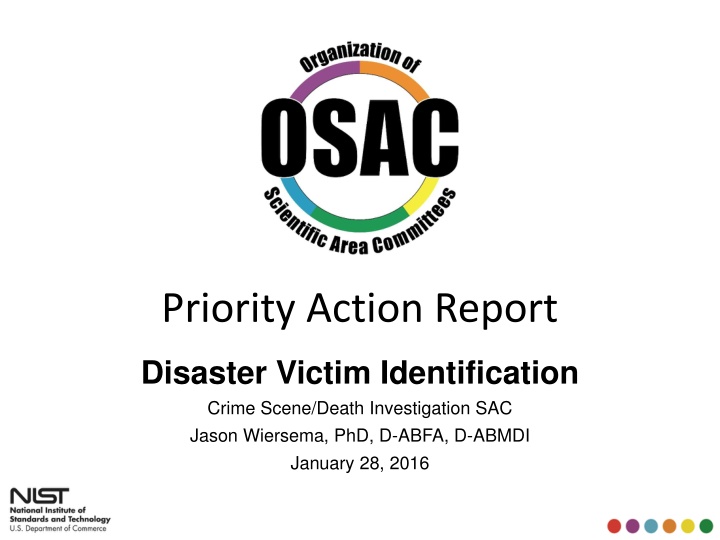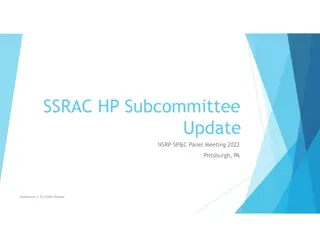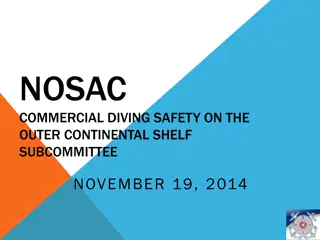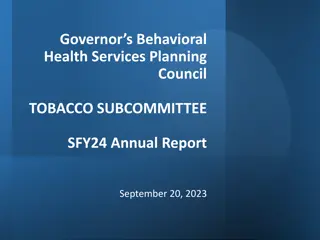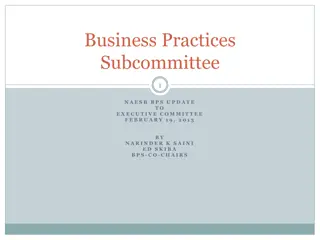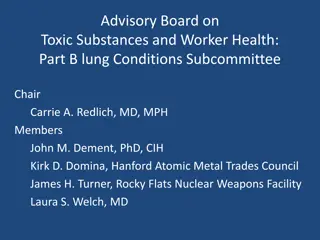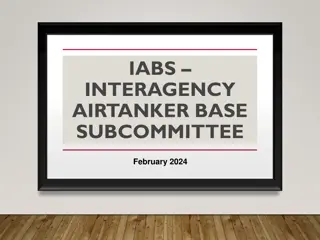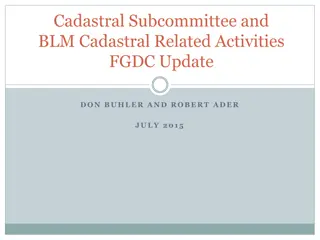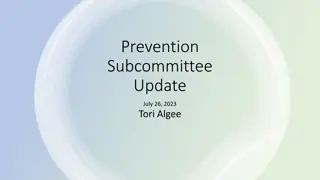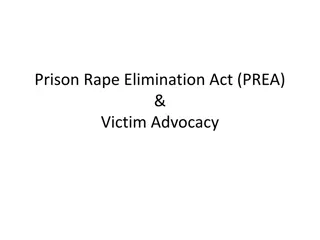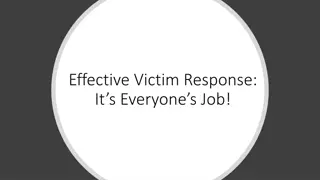Subcommittee on Disaster Victim Identification: Standards and Guidelines
Subcommittee on Disaster Victim Identification aims to enhance scientific foundation by uniting DVI professionals to establish consensus standards and best practices for mass fatality management. Their focus is on supporting medicolegal and emergency management practitioners.
Download Presentation

Please find below an Image/Link to download the presentation.
The content on the website is provided AS IS for your information and personal use only. It may not be sold, licensed, or shared on other websites without obtaining consent from the author.If you encounter any issues during the download, it is possible that the publisher has removed the file from their server.
You are allowed to download the files provided on this website for personal or commercial use, subject to the condition that they are used lawfully. All files are the property of their respective owners.
The content on the website is provided AS IS for your information and personal use only. It may not be sold, licensed, or shared on other websites without obtaining consent from the author.
E N D
Presentation Transcript
Priority Action Report Disaster Victim Identification Crime Scene/Death Investigation SAC Jason Wiersema, PhD, D-ABFA, D-ABMDI January 28, 2016
Subcommittee Leadership Position Name Organization Term Email Harris County Institute of Forensic Sciences DC Office of the Chief Medical Examiner Harris County Institute of Forensic Sciences Chair Jason Wiersema 3(*2) Jason.Wiersema@ifs.hctx.net Vice Chair Dan Morgan 2(*1) Daniel.morgan@dc.gov Executive Secretary Allison Woody 4(*3) Allison.Woody@ifs.hctx.net *years remaining on original term 2
Subcommittee Members # Name Organization Term Email 1 Don Bloom U.S. National Disaster Medical System 4(3) don.bloom@hhs.gov 2 Elissia Conlon Office of the Chief Medical Examiner, New York 3(2) Econlon@ocme.nyc.gov 3 Joyce deJong, D.O. Western Michigan University School of Medicine 3(2) joyce.dejong@med.wmich.edu 4 Dennis Dirkmaat, Ph.D. Mercyhurst University 4(3) ddirkmaat@mercyhurst.edu 5 Benjamin Figura, Ph.D. Office of the Chief Medical Examiner, New York 2(1) bfigura@ocme.nyc.gov 6 Elias Kontanis, Ph.D. U.S. National Transportation Safety Board 3(2) elias.kontanis@ntsb.gov 7 Raymond Miller, D.D.S. State University of New York, Buffalo 4(3) ray2thdoc@aol.com 8 Dan Morgan DC Office of the Chief Medical Examiner 2 (1) Daniel.morgan@dc.gov 9 Thomas Parsons, Ph.D. International Commission on Missing Persons 4(3) thomas.parsons@ic-mp.org 10 Aaron Uhle U.S. Federal Bureau of Investigation 4(3) aaron.uhle@ic.fbi.gov 11 Suzanne Utley-Bobak, M.D. District 12 Medical Examiners Office, Florida 2(1) utleysuzanne@hotmail.com 12 Mark Wadhams U.S. Armed Forces DNA Identification Laboratory 2(1) mark.j.wadhams.ctr@mail.mil 13 Allan Warnick, D.D.S. Wayne County (Ohio) Medical Examiner 3(2) wtoothdoc@aol.com 14 Victor Weedn, M.D., J.D. George Washington University 3(2) vweedn@gwu.edu 15 Jason Wiersema, Ph.D. Harris County (TX) Institute of Forensic Sciences 3 (2) jason.wiersema@ifs.hctx.net 16 Allison Woody Harris County (TX) Institute of Forensic Sciences 4 (3) allison.woody@ifs.htx.net 17 Timothy Zolandz U.S. Federal Bureau of Investigation 2(1) timothy.zolandz@ic.fbi.gov 3
Discipline Description The Subcommittee on Disaster Victim Identification will advance the scientific basis for disaster victim identification by assembling multi-disciplinary professionals from the DVI community in a collaborative effort to develop consensus standards, guidelines and best practices supporting mass fatality/ casualty management for use by domestic and international medicolegal and emergency management practitioners. 4
Summary of Standards/Guidelines Priority Actions Priority Working Title of Document Priority 1 (1 of 6) Standard Practices for DNA Analysis for Human Identification in Mass Fatality Incidents (DVI DNA) Priority 1 (2 of 6) Standard Practices for the Forensic Pathologist in the Disaster Victim Identification Context (DVI Pathology) Priority 1 (3 of 6) Mass Fatality Incident Data Management: Standard Practices for the Medicolegal Authority (DVI Data) Priority 1 (4 of 6) Postmortem Impression Submission Strategy for Comprehensive Searches of Essential Automated Fingerprint Identification System Databases (DVI Print) Priority 1 (5 of 6) Forensic Anthropology in Disaster Victim Identification: Standard Practices for the Medicolegal Authority (DVI Anthropology) Priority 1 (6 of 6) Mass Fatality Incident Scene Processing: Standard Practices for the Medicolegal Authority (DVI Scene) 5
Standards/Guidelines Development Priority 1 Document (1 of 6) Document Title: Standard Practices for DNA Analysis for Human Identification in Mass Fatality Incidents (DVI DNA) Scope: This document addresses the application of DNA testing to a DVI incident response. It provides guidance to medicolegal authorities for the appropriate establishment and management of DNA operations Objective/rationale: There is no existing standard pertaining to DNA collection and management in the DVI setting Issues/Concerns: None. Task Group Name: DVI DNA Task Group Chair Name: Timothy Zolandz Task Group Chair Contact Information: 703-632-8473 Date of Last Task Group Meeting: 1/28/2016 6
Standards/Guidelines Development Priority 1 Document (2 of 6) Document Title: Standard Practices for the Forensic Pathologist in the Disaster Victim Identification Context (DVI Pathology) Scope: The intended scope of this document is to provide standard practice guidelines regarding postmortem data collection by forensic pathologists during a mass fatality incident response Objective/rationale: There is no existing standard pertaining to postmortem data collection by forensic pathologists in the DVI setting Issues/Concerns: None. Task Group Name: DVI Forensic Pathology Task Group Chair Name: Joyce deJong Task Group Chair Contact Information: 269-337-6173 Date of Last Task Group Meeting: 01/28/2016 7
Standards/Guidelines Development Priority 1 Document (3 of 6) Document Title: Mass Fatality Incident Data Management: Standard Practices for the Medicolegal Authority (DVI Data) Scope: The intended scope of this document is to provide standard practice guidelines for the management of DVI data (antemortem and postmortem) Objective/rationale: There is no existing standard pertaining to the management of DVI data Issues/Concerns: None. Task Group Name: DVI Data Management Task Group Chair Name: Jason Wiersema Task Group Chair Contact Information: 713-796-6747 Date of Last Task Group Meeting: 01/28/2016 8
Standards/Guidelines Development Priority 1 Document (4 of 6) Document Title: Postmortem Impression Submission Strategy for Comprehensive Searches of Essential Automated Fingerprint Identification System Databases (DVI Print) Scope: The intended scope of this document is to provide standard practice guidelines regarding postmortem fingerprint impression evidence during a mass fatality incident response Objective/rationale: There is no existing standard pertaining to postmortem fingerprint collection that adequately addresses the mass fatality context Issues/Concerns: None. Task Group Name: DVI Fingerprint Task Group Chair Name: Aaron Uhle Task Group Chair Contact Information: 703-632-7137 Date of Last Task Group Meeting: 01/28/2016 9
Standards/Guidelines Development Priority 1 Document (5 of 6) Document Title: Forensic Anthropology in Disaster Victim Identification: Standard Practices for the Medicolegal Authority (DVI Anthropology) Scope: The intended scope of this document is to provide standards regarding the application of forensic anthropological methods in the mass fatality context Objective/rationale: There is no existing DVI specific standard pertaining to the application of forensic anthropological methods in the mass fatality context Issues/Concerns: None. Task Group Name: DVI Anthropology Task Group Chair Name: Dennis Dirkmaat Task Group Chair Contact Information: 814-397-3771 Date of Last Task Group Meeting: 01/28/2016 10
Standards/Guidelines Development Priority 1 Document (6 of 6) Document Title: Mass Fatality Incident Scene Processing: Standard Practices for the Medicolegal Authority (DVI Scene) Scope: The intended scope of this document is to provide standards for the management of human remains recovery from a mass fatality incident scene Objective/rationale: There is no existing standard pertaining to management human remains recovery following a mass fatality incident Issues/Concerns: None. Task Group Name: DVI Scene Processing Task Group Chair Name: Dennis Dirkmaat Task Group Chair Contact Information: 814-397-3771 Date of Last Task Group Meeting: 01/28/2016 11
Priority 1: 6 documents identified as Priority 1 (DVI DNA, DVI Path, DVI Data, DVI Print, DVI Anthropology, DVI Scene) Task Group/Subcommittee Action Plan OSAC Process Stage (e.g., SDO 100) Estimated Completion Date Planned Actions Assignee Submit documentation to request SAC approval to initiate SDO submission SDO-100 Wiersema 1/29/2016 Identify relevant SDO (AAFS ASB) SDO-200 Wiersema Upon receipt of SAC approval of SDO-100 Submit packet to AAFS ASB SDO-300 Wiersema Upon completion of SDO-100 and 200 12
Summary of Standards/Guidelines Priority Actions Priority Working Title of Document Priority 1 (1 of 6) Standard Practices for DNA Analysis for Human Identification in Mass Fatality Incidents (DVI DNA) Priority 1 (2 of 6) Standard Practices for the Forensic Pathologist in the Disaster Victim Identification Context (DVI Pathology) Priority 1 (3 of 6) Mass Fatality Incident Data Management: Standard Practices for the Medicolegal Authority (DVI Data) Priority 1 (4 of 6) Postmortem Impression Submission Strategy for Comprehensive Searches of Essential Automated Fingerprint Identification System Databases (DVI Print) Priority 1 (5 of 6) Forensic Anthropology in Disaster Victim Identification: Standard Practices for the Medicolegal Authority (DVI Anthropology) Priority 1 (6 of 6) Mass Fatality Incident Scene Processing: Standard Practices for the Medicolegal Authority (DVI Scene) 13
Research Gaps Identified (3) 1. There is a lack of understanding of the degree of cognitive bias that may be associated with high throughput disaster victim identification operations. There are two closely associated research needs: Determine if cognitive bias exists in current DVI operations Develop effective mitigation strategies 2. There is currently no means to anticipate the volume and variety of data that result from, and must be managed following a mass fatality incident. The existing assumptions are anecdotal and based on a small number of incidents. The volume of data (missing persons call centers, victim information centers, hospitals, law enforcement etc.) available from previous incident after action reports should be used to systematically develop reliable expectations for medicolegal operations 3. There is currently no means to quantify the individualistic value of contextual identifiers, and thus no measure of confidence associated with contextual decedent identifications. There is a need for development of population-level likelihood values for human characteristics/circumstances that are regularly used in support of scientific identification methods (including scars/marks/tattoos, body location, etc) 14
Priority Action Report Disaster Victim Identification Crime Scene/Death Investigation SAC Chair: Jason Wiersema PhD DABFA, DABMDI January 28, 2016
